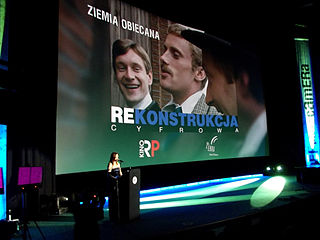Related Research Articles

The history of cinema in Poland is almost as long as the history of cinematography, and it has universally recognized achievements, even though Polish films tend to be less commercially available than films from several other European nations.
Articles related to Mongolia include:

The culture of Mongolia has been shaped by the country's nomadic tradition and its position at the crossroads of various empires and civilizations. Mongolian culture is influenced by the cultures of the Mongolic, Turkic, and East Asian peoples, as well as by the country's geography and its history of political and economic interactions with other nations.

The Story of the Weeping Camel is a 2003 German docudrama distributed by ThinkFilm. It was released internationally in 2004. The film was directed and written by Byambasuren Davaa and Luigi Falorni. The plot is about a family of nomadic shepherds in the Gobi Desert trying to save the life of a rare white bactrian camel calf after it was rejected by its mother.

Cinema of Colombia refers to film productions made in Colombia, or considered Colombian for other reasons. Colombian cinema, like any national cinema, is a historical process with industrial and artistic aspects.

Byambasuren Davaa, also known as Davaagiin Byambasüren, is a Mongolian filmmaker currently residing in Germany.

Bulgaria has been producing films since 1915. Bulgarian cinema is known for the pioneering work of directors like Donyo Donev in the field of animation. The filming and screening of Vasil Gendov's film Bulgaran are Gallant (1915) is considered to be the beginning of Bulgarian cinematography. Historically, Bulgarian films have been noted for their realism, social themes and technical innovation.

Cinema of Estonia is the film industry of the Republic of Estonia. The motion pictures have won international awards and each year new Estonian films are seen at film festivals around the globe.

Ukrainian cinema comprises the art of film and creative movies made within the nation of Ukraine and also by Ukrainian film makers abroad.

Hungary has had a notable cinema industry since the beginning of the 20th century, including Hungarians who affected the world of motion pictures both within and beyond the country's borders. The former could be characterized by directors István Szabó, Béla Tarr, or Miklós Jancsó; the latter by William Fox and Adolph Zukor, the founders of Fox Studios and Paramount Pictures respectively, or Alexander Korda, who played a leading role in the early period of British cinema. Examples of successful Hungarian films include Merry-go-round, Mephisto, Werckmeister Harmonies and Kontroll.

Cinema of Azerbaijan dates back to the 19th century. Azerbaijan is one of the first countries in the world involved in cinematography. The first Azerbaijani film was a thirty second long silent film called The Oil Gush Fire in Bibiheybat, which was recorded using the cinematograph.

Films have been made in Lithuania since the early twentieth century.

Cinemas of Latvia date back to 1910 when the first short films were made. The first cinematic screening in Riga took place on May 28, 1896. By 1914, all major cities in Latvia had cinemas where newsreels, documentaries, and mostly foreign-made short films were screened.

The cinema of Cyprus came into existence much later than the cinema of most other countries, with the late 1960s generally being accepted as its earliest history, and it has generally undergone extremely slow growth due to the island's small population, geographical location, a lack of interest, and more attention being given to local political tensions.
In parallel to what happened in other Soviet republics, a cinema of Tajikistan was promoted by the Soviet state, and declined in the first years after the independence, before being revitalized through the efforts of the new government.

The cinema of Moldova developed in the early 1960s during the Soviet period, experiencing a flowering of about a decade and a half. Stagnation followed, and after the Moldavian SSR became independent in 1991, the industry almost completely disappeared.

Cinema of North Macedonia refers to film industry based in North Macedonia or any motion-picture made by Macedonians abroad. Janaki and Milton Manaki are considered the founding fathers. The first feature film produced by the country was Frosina (1952) and the most famous director is Milčo Mančevski. The first and only Macedonian movie theater chain is Kinoverzum.
The Two White Horses of Genghis Khan is a Mongolian epic in alliterative verse, with a number of different versions. It is one of the oldest Mongolian literary works and supposedly hails from the 13th/14th century.

Cinema of Kazakhstan refers to the film industry based in Kazakhstan. Cinema in Kazakhstan can be traced back to the early 20th century. Today, Kazakhstan produces approximately fifteen full-length films each year.
Jigjidsüren Gombojav is a Mongolian film director and screenwriter. His films include The First Steps (1974), The Legend of Mother Oasis (1975), Khatan-Bator (Хатанбаатар) (1981), Tears of the Rock Monument (1990), Warm Ashes (1991), and Traces of Existence (1992). He was awarded the highest honor in Mongolia for artists, the People's Artist of Mongolia, in 2007 for his contribution to Mongolian cinema and television, and the highest literature award in Mongolia, D. Natsagdorj Literature Award, in 2011 for his documentary film about the poet D. Natsagdorj.
References
- ↑ "Table 8: Cinema Infrastructure - Capacity". UNESCO Institute for Statistics. Archived from the original on 5 November 2013. Retrieved 5 November 2013.
- ↑ "Table 6: Share of Top 3 distributors (Excel)". UNESCO Institute for Statistics. Archived from the original on 24 December 2018. Retrieved 5 November 2013.
- ↑ "Table 1: Feature Film Production - Genre/Method of Shooting". UNESCO Institute for Statistics. Archived from the original on 24 December 2018. Retrieved 5 November 2013.
- 1 2 "Table 11: Exhibition - Admissions & Gross Box Office (GBO)". UNESCO Institute for Statistics. Archived from the original on 3 November 2013. Retrieved 5 November 2013.
